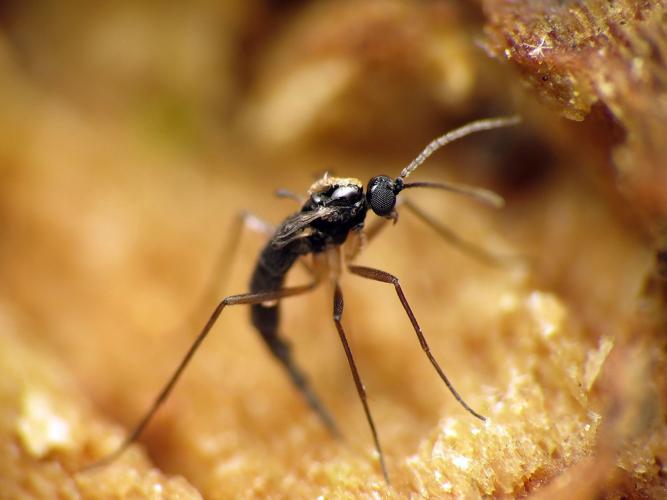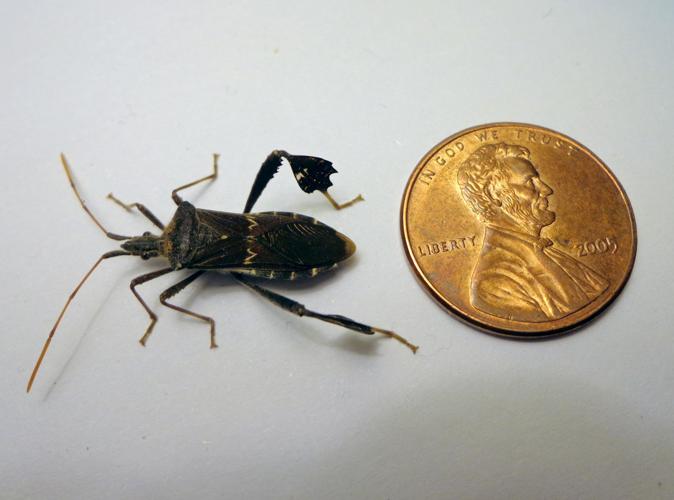Question: We have tiny black gnat-like bugs flying around the house. They seem to live in the dirt of my plants and though they don’t bite, they annoy us endlessly. I put the plants outside to see if the change in temperature would encourage them to fly away but to no avail. They seem to end up even in rooms with no plants. We read somewhere to put dishes of soapy water out and we do catch a few this way, but I’d rather find a permanent way to rid myself of the annoying pests.
Answer: Your gnats are living on fungi in the soil of your plants. For this reason, we often call them fungus gnats. Unfortunately, the photo you sent wasn’t close enough to help identify which species. Fortunately, these are common insects in houseplants so we have a good understanding of their life cycle and some general methods for managing them. As you noticed, they don’t bite; in fact the adults don’t even feed. The adults are only alive for a week or so and their mission is to mate and lay eggs in the soil. They may fly to other rooms nearby seeking places to lay eggs. The larvae feed on decaying plant matter and fungi in the soil and complete their development in three to four weeks. The first step in managing them is to let the top 1 or 2 inches of soil dry out completely between watering. This step alone might be enough to solve your problem. If the population persists for a month after you change watering practices, you might need to use an insecticide. There are a few available including Bacillus thuringiensis israelensis (Bti), pyrethroid-based insecticides and parasitic nematodes. Some of these are not easy to find in stores so you might need to order them online.
Question: The last couple of years, the fruit on my pom tree gets brown spots, and it is rotten inside. Any ideas?
Answer: Yes, it’s likely that insects are feeding on your pomegranate fruit and the feeding allows entry for a fungus that subsequently rots the fruit. The most likely suspect is the leaf-footed bug (Leptoglossus species). There are three species in the Southwest. These insects are common in our area and may be found feeding on a variety of plants including citrus, pecans and pomegranates. As adults, these insects are difficult to manage because they can fly, they can sense predators and they are quick to run around the other side of the plant or fly away. The best time to remove them is when they are in the egg stage, laid in a strand — end to end on the underside of leaves. There are insecticides available and effective against newly hatched nymphs. Either of these requires monitoring your pomegranate tree on at least a weekly basis with the goal of detecting them before they mature to the adult stage. If you only have one tree and you are looking closely for them anyway, you might be able to just remove them by hand or sweep them into a bucket of soapy water.
Question: This question is a shot in the dark concerning a bushy plant we saw in Alton, Illinois, this past September. The cluster berries are striking in their vibrant color. No one we spoke with including park personnel knew what the plant was called. It was in a landscaped area, and planted in a manner that would suggest a landscape architect was involved. Any guess?
Answer: The plant is American beautyberry (Callicarpa americana). It is native to the southeastern U.S. from Texas to Virginia and is easily grown in that area. I had it growing in my front yard in Virginia and it really tied the landscape together. It has also been found in the Caribbean and northern Mexico as it adapts to a wide range of soil pH. It is a striking plant and there is a variety called “lactea” with white berries that is sold by nurseries although it can’t compare to the purple in my opinion.
Question: Is it necessary to cut back our red bird-of-paradise bushes in the late winter (here in Sierra Vista)? Some folks in town don’t and their red birds seem to bloom OK. Is it also necessary to cut back (or really, cut down) our Tecoma stans-orange jubilee each winter?
Answer: There are three species of bird of paradise (Caesalpinia) grown in the Southwest, red (C. pulcherrima), yellow (C. gilliesii), and Mexican (C. mexicana). In general, the pruning of bird of paradise shrubberies is necessary only to remove frost-damaged limbs or to remove dead, crossing or damaged branches. More pruning will be needed if you are growing the Mexican bird of paradise and plan it to be developed and maintained as a small tree. Once blooming is finished, the flower stalks may be removed to prevent seedpods from forming and to reduce the likelihood of volunteer seedlings. If the pods are left on the plant to dry and split, the seeds can be thrown a surprising distance. The red bird of paradise dies back to the ground at temperatures below freezing. It generally regrows in spring from the ground and can be pruned to a few inches above the ground in late winter. Mulching the base of plants in colder areas may protect the crown until spring. For Tecoma stans, it is not necessary to cut way back or cut them down each winter. Generally, you should prune dead wood in early spring and otherwise just do light selective thinning as needed to maintain the size. Hard pruning Tecoma stans-orange jubilee back to 12-inch canes is sometimes done to reduce the size and to maintain its upright shape. Hard pruning is stressful for the plants so if you choose that method you might do it every third year.






